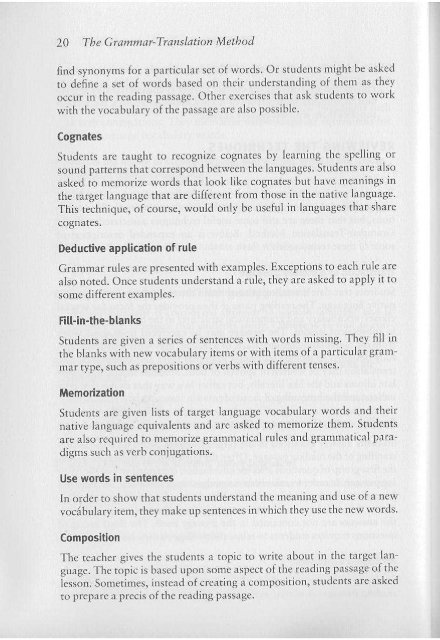Diane Larsen-Freeman
larsen-freeman-techniques-and-principles-in-language-teaching
larsen-freeman-techniques-and-principles-in-language-teaching
- No tags were found...
Create successful ePaper yourself
Turn your PDF publications into a flip-book with our unique Google optimized e-Paper software.
20 The Grammar-Translation Method<br />
find synonyms for a particular set of wor ds. Or students might be asked<br />
to define a set of words based on their understandin g of them as they<br />
occur in the reading passage. Other exe rcises that ask students to wor k<br />
with the vocabu lar y of the passage arc also possible.<br />
Cognates<br />
Students arc taught to recognize cognates by learni ng the spelling or<br />
sou nd patterns that correspond between the languages. Students arc also<br />
asked to memor ize wor ds that look like cognates but have meanings in<br />
the rargcr langu age that are different from those in the native language.<br />
This technique, of cou rse, would onl y be useful in languages that share<br />
cognates.<br />
Deductive application of rule<br />
Grammar rules arc presented with examples. Exceptio ns to each rule arc<br />
also noted. Once students understand a rule, they are asked to apply it to<br />
some different examples.<br />
Fill-in·th e-blanks<br />
Students arc given a series of sentences with words missing. They fill in<br />
the blanks with new vocabulary items or wit h items of a par ticular grammar<br />
type, such as prepositions or verbs with different tenses.<br />
Memorization<br />
Students are given lists of target langu age voca bulary words and their<br />
native langu age equivalents and are asked to memorize them. Students<br />
are also required to memorize grammatica l rules and grammatica l paradigms<br />
such as verb conjugations.<br />
Use words in sentences<br />
In order to show that students understand the meanin g and use of a new<br />
vocabu lary item, they nuke up sentences in which they use the new words.<br />
Composition<br />
The teacher gives the students ;1 topi c to write "hour in the target language.<br />
Th e topi c is based upon some aspect of the reading passage of th e<br />
lesson. Sometim es, instead of creat ing a composition, students arc asked<br />
to prepare a precis of the reading passage.<br />
CONCLUSION<br />
The Grammar-Translation Method 2 1<br />
You have now had an opportunity to exa mine the principles and some of<br />
the techniques of the Gra mma r-Tra nslat ion Method. Try ro make a connection<br />
between what you have understood and your own teaching situation<br />
and beliefs.<br />
Do you believe th at a fundamental reason for learning a foreign language<br />
is to be ab le ro read the literature written in the ta rget language? Do<br />
you think it is important to learn about the target language? Should culture<br />
be viewed as consisting of literature and the fine arts? Do you agree<br />
with any of the oth er principles underlying the Grammar-Translation<br />
Meth od? Whic h ones?<br />
Is trans lation a valuable exercise? Is answering reading comprehension<br />
questions of the type described here helpful? Should gra mmar be presented<br />
deductively? Are these or any of the other techniques of the<br />
Grammar-Translation Method ones which will be useful ro you in your<br />
own teach ing? Which ones?<br />
ACTIVITIES<br />
A Check your understanding of the Grammar-Translation Method.<br />
1 It has been said that the Grammar-Trans lation Method teac hes students<br />
about the targe t language, but not how to use it. Explain the difference<br />
in your own wor ds.<br />
2 Wbat are the clues that this meth od had its or igin in the teaching of the<br />
classical languages, Latin and Greek?<br />
B Apply what you have understood about the Grammar-Translation<br />
Method.<br />
1 Think of a particular group of students you have recently taught or arc<br />
currently teaching. Choose a reading passage from a literary work or a<br />
textbook or writ e one yourself. Make sure it is at a level you r students<br />
can understand, yet not at a level t hat wou ld be too simp le for them.<br />
Try tran slating it yourself as a test of its difficulty. Identify the vocab u<br />
lary you woul d choose to work on. Plan vocabulary exercises you<br />
wou ld usc to help your students associat e the new words with their<br />
nativ e language equivalents.<br />
2 Pick a grammatical point or two contained in the same passage.<br />
Pro vide th e explicit grammar rule that relates to each one and give


